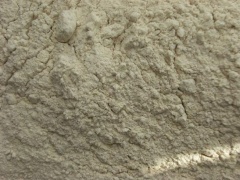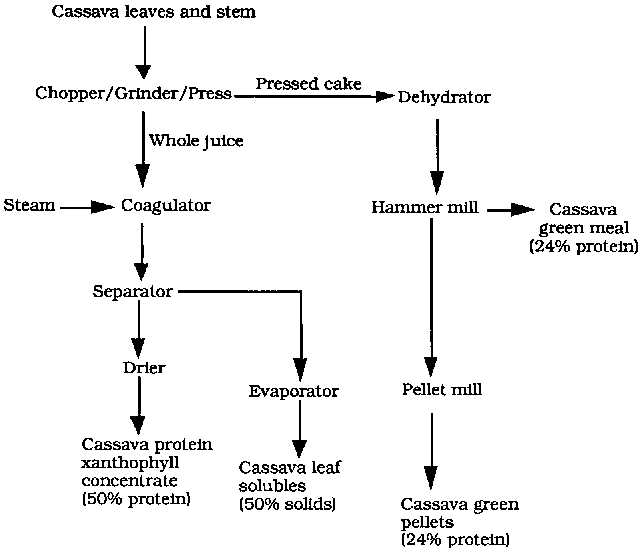Difference between revisions of "Cassava Meal"
| Line 16: | Line 16: | ||
====<b>Processing of cassava into chips and pellets</b>==== | ====<b>Processing of cassava into chips and pellets</b>==== | ||
The flow chart for this process is shown in figure 1. | The flow chart for this process is shown in figure 1. | ||
| − | The production of chips is an intermediate stage in the production of pellets. There is very little difference in the technologies used at different scales of chip and pellet production. The main difference is in sun-drying and mechanical drying. Chips can be produced by very simple techniques in the household or village as well as on a large mechanized scale. | + | The production of chips is an intermediate stage in the production of pellets. There is very little difference in the technologies used at different scales of chip and pellet production. The main difference is in sun-drying and mechanical drying. Chips can be produced by very simple techniques in the household or village as well as on a large mechanized scale.<br><br> |
| + | [[File:Cassave_meal_flow_chart.gif]] | ||
Revision as of 11:27, 9 January 2013
| Infobox on Cassava Meal | |
|---|---|
| Example of Cassava Meal |  |
| Facts | |
| Origin | Asia |
| Stowage factor (in m3/t) | 1,7/1,8 m3/t (bulk/pellets) |
| Humidity / moisture | 12-14% |
| Ventilation | See text |
| Risk factors | See text |
Cassava Meal
Description
The Cassava Root is long and tapered, with a firm, homogeneous flesh encased in a detachable rind, about 1mm thick, rough and brown on the outside. Commercial varieties can be 5 to 10 cm in diameter at the top, and around 15 cm to 30 cm long. A woody cordon runs along the root's axis. The flesh can be chalk-white or yellowish. Cassava roots are very rich in starch, and contain significant amounts of calcium (50 mg/100g), phosphorus (40 mg/100g) and vitamin C (25 mg/100g). However, they are poor in protein and other nutrients. In contrast, cassava leaves are a good source of protein (rich in lysine), but deficient in the amino acid methionine and possibly tryptophan.
The most common types of feedstuffs produced from cassava roots are chips and pellets. Chips are the dried shredded root and are of variable size, shape, and quality depending on rate of drying and contamination with sand during the processing. The chips can be directly ground and used in mixed feeds or pelleted. The root pellet is a uniform cylindrical product of about 0.5 to 0.8 cm diameter and 1.0 to 2.0 cm long. Pelleting produces a more compact product and reduces dust, thus facilitating storage and transportation.
Pellets have a lower nutritional value than chips because they include part of the shoot, which increases fiber and ash content from 1.5 to 2.0%. Cassava root meal is mainly a source of energy, with a high starch content (about 60-70%). However, the level of protein is very low, being approximately 2.5% of dry matter. Thus, the inclusion of cassava in diets depends on cost and availability of other energy and protein sources. When a balanced poultry ration is formulated, the cassava must be supplemented with protein, amino acids, fat, minerals, and vitamins at higher levels than are needed in cereal-based diets. Cassava root products are deficient in carotene and other coloring carotenoids. Consequently these elements must be added to cassava based
diets if the market requires a high degree of pigmentation of Egg Yolk or broiler skin. Because cassava pellets are high in potassium, limiting their inclusion to reduce the moisture content of feces may be appropriate.
The cassava plant, made up of the roots, leaves and stem, is a good source of carbohydrate and protein. The different parts of the plant can be used as animal feed. The leaves can be used as silage, dried for feed supplementation and as leaf meal for feed concentrates. The stem can be mixed with leaves and used as ruminant feed, or dried for feed concentrates. The roots can be chipped or pelletized and used as feed, while the root peel, broken roots, fiber and baggase from starch extraction and gari processing can be dried and used directly as animal feed or as substrate for single cell protein production. The use of cassava root as animal feed is increasing in importance in the developing countries of Latin America and Asia where an export market for this commodity has developed. The European Economic Community imports about 6 million tonnes of cassava annually in the form of pellets or granules. Thailand and Indonesia are the world's largest exporters of dried cassava products, largely in the form of pellets. In Thailand, cassava is almost entirely utilized as cassava pellets and starch for export.
Processing of cassava into chips and pellets
The flow chart for this process is shown in figure 1.
The production of chips is an intermediate stage in the production of pellets. There is very little difference in the technologies used at different scales of chip and pellet production. The main difference is in sun-drying and mechanical drying. Chips can be produced by very simple techniques in the household or village as well as on a large mechanized scale.












